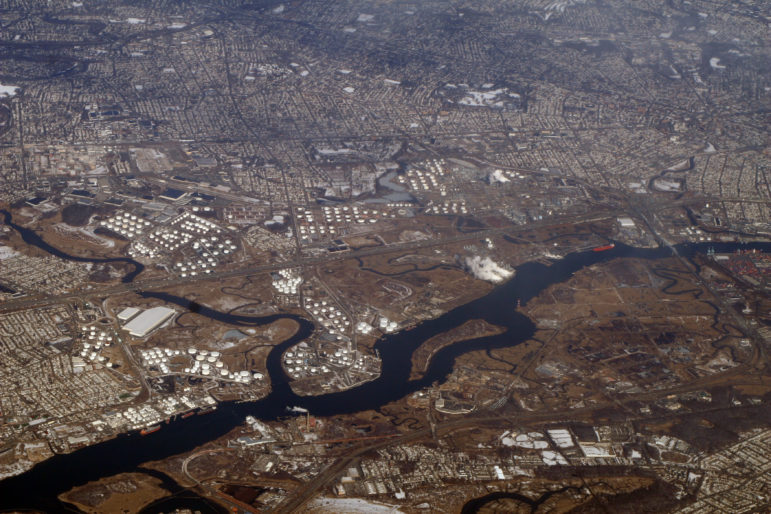
dsearls
The Arthur Kill separating Staten Island from New Jersey will be part of the city's open water sewage-overflow reduction plan.
New York City has been dogged for decades by federal and state regulators over the antiquated sewage system that every year releases billions of gallons of untreated wastewater into local waterways, and it recently asked Albany for a 15-month extension on a final plan for reducing those “combined sewer overflows”—a plan that is already a year overdue and is likely to involve multimillion-dollar construction projects that take many years to complete.
Things, in other words, are not exactly moving at light speed.
But the de Blasio administration told a roomful of water advocates on Wednesday night that the schedule cannot accommodate actually giving the public a look at the city’s proposal before it is final.
Instead of allowing the public to see their full, 500-plus-page technical proposal to the state, the Department of Environmental Protection (DEP) will only allow the public a chance to comment on a synopsis featuring “plain language” and, one agency official promised, attractive graphics.
Looking out for No. 2
The plan in question is the last in a set of 11 “long term control plans” the city agreed to draft under a 2012 consent order.
Each plan lays out a strategy for reducing combined sewer overflows or CSOs, which occur when rainwater overwhelms older parts of the sewer system in which stormwater and wastewater mix. Those overflows put fecal bacteria into rivers, creeks, bays and canals, which make them unhealthy to swim in and depletes the oxygen that fish need to survive. The plans report a load of data on current conditions and detail the strategies DEP wants to pursue and their projected impact.
The 10 plans produced so far have addressed individual waterbodies like the Bronx River or Paerdegat Basin. Advocates have raised a lot of objections over those plans because they generally don’t promise to end overflows, just to reduce them, and sometimes involve the use of chlorine to disinfect water, which some critics think could cause more harm than good.
This last, pending plan covers the city’s open waters: everything from the Hudson, Harlem and East Rivers to Long Island Sound, the lower New York Harbor, Arthur Kill and Kill van Kull. It’s a big deal, it’s likely to propose expensive capital projects and it’s complicated. It even involves cooperating with New Jersey, a U.S. state that apparently lies on the western side of the Hudson River.
Plans and process
Typically, when the city proposes a big and complicated thing, it has to reveal details and allow the public to comment on them before reaching a final decision. That’s true of rezonings, new agency regulations, changes to the building code, laws, charter revisions, school closings, service contracts and other wonky stuff.
That kind of transparency is usually deemed appropriate because the devil is in the details: The public can’t be expected to have a meaningful voice if it is not allowed to know what it’s really commenting on. Detail is especially devilish in the realm of water policy, where there’s often passionate disagreement between advocates and city officials even over how to measure how many poopy germs are in the water, let alone what to do about them.
But while DEP has informed the public about what it was considering doing in each of the 10 previous CSO-reduction plans, it has never revealed the details of its final proposals before it sent those blueprints to Albany. And the state doesn’t do any public review at all.
At a City Council hearing last year, DEP came under scrutiny for this practice and promised to do better as it prepared this final citywide CSO-control plan.
Now DEP has come up with what it depicts as a compromise: It will show the public a sketch of the options it’s considering, take comments on those, then reveal what actions it wants to take, and take more comments, before filing the actual plan to the state. The actual plan still wouldn’t get public review.
DEP’s argument: It doesn’t have time to let the public pick apart its actual, detailed plan. “We are limited in the time we have to execute these LTCPs,” said Mikelle Adgate, the director of stormwater management outreach. “The original due date was December 2017. We are really not looking to extend that process any further.”
Flushing and rushing
Many water advocates give the city credit for improving vastly on what public engagement used to be like. The citywide planning process now underway had not one but three kickoff meetings around the city. This improved outreach parallels DEP’s success at dramatically reducing CSO outflows and improving water quality along much of the New York coastline. Among other initiatives, the agency has committed more than a billion dollars to green infrastructure, taken new steps to reduce litter in the waterways and tested a new app to try to get people to use less water during storms, when CSO events are more likely.
But like a swimmer struggling to reach shore, it’s those last few yards that really count. Many city waterways continue to fall short of health standards. And the approach to public engagement, critics say, still fails to respect the depth of civic interest in the health of New York’s coast. Advocates say the city owes it to the public, to the water and to all the years of waiting to do this last plan right.
“Nobody gets to see the report and comment on it before it gets finalized?” asked an incredulous Larry Levine, senior attorney at Natural Resources Defense Council. “There’s still a major disconnect there.”









One thought on “De Blasio Administration, Advocates Clash Over the Transparency of City’s Clean Water Plans”
Pingback: Purify Your Water Naturally – Filtered Water Online